Baseball Catcher Blocking Techniques
Learning basic baseball catcher blocking techniques, or maybe I should say striving to master the basics, is always the first step in our building block system of skill enhancing. The presentation of an impenetrable wall, which stops all wild pitches dead in their tracks, is the ultimate goal of every catcher, and I’m going to teach you a few “Tricks of the Trade” which increases your chances of success.
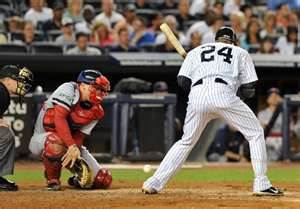
Trick One: Pitches Thrown to the Side
A wild pitch is exactly that, a ball thrown without control, so obviously not all bad pitches will be thrown directly at you, but will also be thrown to your sides. The basic mechanics of dropping and covering are essentially the same, but you can’t drop straight down, the ball won’t be there, it’ll be on you side.
Your task is how do you move your body sideways in order to put yourself in front of the ball. There are 2 basic methods to accomplish this.
(1.) The Leap Frog method, requires you to push off with both feet, resembling the action of a frog leaping, and drop into your blocking position as you land on your knees.
(2.) The Slide method, requires you to take a jab step, or short step, with your lead foot, right foot for right side of the plate, left for left side, while dragging your rear foot, moving into your blocking position as you slide sideways.
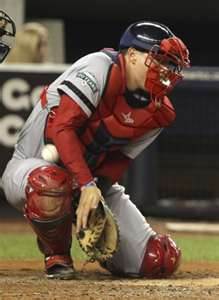
Baseball Catcher Blocking Techniques
Both methods are correct and is just a matter of the catcher’s personal preference which one is utilized. I’d suggest experimenting with both methods to see if one is easier for you to execute over the other, which would be your primary method, but never restrict yourself to one move, practice both.
Another physical adjustment required for blocking wild pitches to the side, is a slight angling of the hips and shoulders, in order to stay square with the ball. Remembering our basics, we want our body square, not angled, when blocking the ball, as square results in the ball bouncing straight out in front of us, where angled will shoot the ball off to the side and away from us. There are a couple of things to remember when executing our drop.
Clickbank Products
There are a couple of things to remember when executing our drop.
(1.) Your goal is to keep your body square with the Pitcher, not the baseball. Your point of origin is the pitcher, the ball could be traveling at any angle as there is no control, by staying square (directly facing) the pitcher, you will always be square to the pitch, which produces a frontal bounce.
(2.) The easy way to accomplish this slight adjustment is to remember the lead shoulder should always be slightly in front of the rear shoulder. If the throw is to your right, the right shoulder should be slightly in front of the left, and visa versa if the ball is to your left.
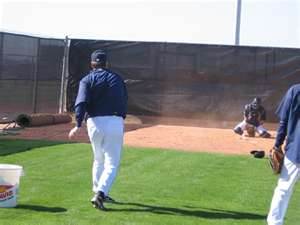
Blocking Breaking Balls
Baseball Catcher Blocking Techniques
Trick Two: Analyzing Breaking Balls
It’s important to know a breaking ball, because of the spin of the ball, will bounce differently than a fastball when it strikes the ground, as the spin will make the ball bounce backwards the opposite direction it was traveling.
For example, the baseball released by a right-handed pitcher, throwing a slider or curve ball, will break down and right as the catcher faces it, but hitting the dirt the ball will either bounce back to the catcher’s left, or straighten out and bounce straight towards the backstop.
This direction of change, due to the spin, is usually quite minimal, but in certain situations it could prove pivotal in how much the catcher compensates his body movement. One way to insure this quirk doesn’t ever have an impact on your catching is to know your pitching staff and how tight of a spin each pitcher throws, and that’s learned in the bullpen catching each of them.
On the subject of breaking balls, here’s another tip. You have called for a breaking ball, slider or curve, and the pitcher bounces the ball 8 - 10 feet in front of the plate, your training has taught you to drop and block, but as with everything else in baseball, there’s always the exception.
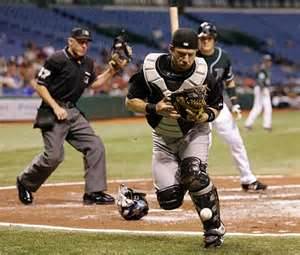
No, It's Not In The Mitt
Baseball Catcher Blocking Techniques
If you drop to your blocking position, the ball will bounce over your head or shoulder, unless you’re real lucky, then it’ll smash into your face mask. For this type of pitch, remain low in your standing crouch position, and read the bounce of the ball. If it bounces high, block it with the upper part of your body and mitt, bounces low, drop to your normal blocking position.
Trick Three: Pass Balls/Wild Pitches
No matter how good you are everyone, even you, will always experience a ball getting by them and going to the backstop, it’s just a fact of life. Now that we’ve admitted we’re human, let’s learn how to retrieve the ball quickly and get it back into play in order to limit the damage.
If the ball gets away from you with runners on base, including a muffed third strike, it’s important to get to ball as quickly as possible.
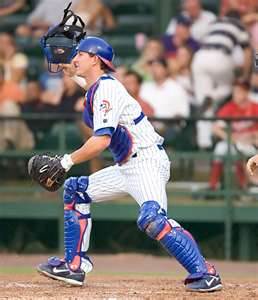
Beginning To Peel Off To The Right
Baseball Catcher Blocking Techniques
(1.) Do not turn and run straight back to get the ball, because you’ll run straight into the umpire. If the ball went by on your left side, you should peel off to your left and pursue the ball, avoiding the umpire. The ball passes on your right, peel off to the right and pursue.
(2.) As you approach the baseball slide with your throwing leg ( normally right leg as catchers are normally right handed) out in front, which allows you to pop up and immediately be on your plant foot for throwing.
(3.) When fielding the ball, either reach for it with your bare throwing hand, or pick it up in a shovel motion with your mitt and bare hand. You don’t want to be fumbling for the baseball.
If there was a runner on third, or possibly second, always anticipate and execute as if there will be a play at the plate. You should have a feel for where home plate is even though it’s to your back, because you know if your ran straight back or to an angle. Field the ball, wheel around and throw the ball to the plate. You notice I didn’t say throw it to the pitcher covering, which he should be, but you don’t have the time to verify he’s doing his job correctly. Throw the ball immediately.

Preparing to Slide
Baseball Catcher Blocking Techniques
For a play at first base, say a dropped third strike, field the ball, take a short crow hop and throw to first. If the play is so close you are forced to throw with only your arm, without a crow hop or shuffle, you probably won’t be able to get the out anyway.
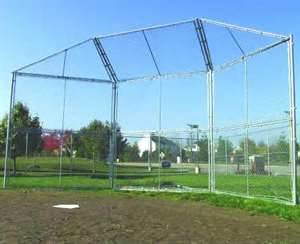
Baseball Catcher Blocking Techniques
Close

FAR
Probably the most defining issue on how you’ll play a passed ball is the location of the backstop and physical make-up. If you’re playing on a large field and the backstop is deep behind the plate, you know you will not be able to throw a runner out at first on a passed 3rd strike. However, if the backstop is closer and the lower section is encased with wooden boards, in order to protect the chain link fencing, you know the ball will bounce right back to you, or if it doesn’t reach the backstop, is well within range to still reach the ball and throw the runner out.
1. Get to a passed ball as quickly as possible.
2. Stop a wild pitch by whatever means it takes
Baseball Catcher Blocking Techniques to Baseball Catcher Position
Baseball Catcher Blocking Techniques to Home Page

New! Comments
Have your say about what you just read! Leave me a comment in the box below.